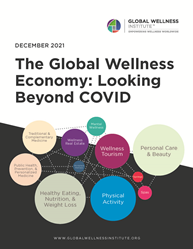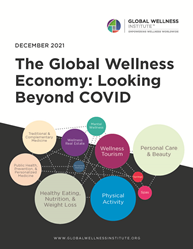
This research update is crucial, because 2020 is the watershed year that will forever divide history–and the trajectory of the wellness economy–into ‘before’ and ‘after’ COVID-19
BOSTON (PRWEB)
December 01, 2021
The nonprofit Global Wellness Institute (GWI) today unveiled its much-anticipated research report, “The Global Wellness Economy: Looking Beyond Covid”, which provides new global market data on the overall wellness economy and for each of its eleven sectors. The 100-page report answers the big questions: How did the shock of COVID-19 impact the wellness industry? Which wellness markets fared best and worst? What is the future of the wellness economy–and why?
The GWI last measured the wellness industry at $4.3 trillion in 2017, and the new research reveals that it grew to historic levels in the two years before the pandemic, reaching $4.9 trillion in 2019. With the massive economic shocks from COVID-19, the global wellness economy fell 11%, to $4.4 trillion, in 2020. But with the pandemic ushering in a major shift in values for consumers, governments, and the medical world–where prevention and wellness take on far greater importance–the GWI predicts that the wellness market will return to pre-pandemic levels in 2021 ($5 trillion), and will grow at an impressive 10% annual pace through 2025, when it will reach $7 trillion.
The report, released today at the Global Wellness Summit in Boston, is the GWI’s most in-depth research on wellness markets ever: For the first time, it provides detailed numbers and analysis for all eleven wellness sectors: pre-pandemic, pandemic, and future growth rates; rich regional and national data; and the major trends that will impact each sector post-COVID.
The report is free to download here.
“This research update is crucial, because 2020 is the watershed year that will forever divide history–and the trajectory of the wellness economy–into ‘before’ and ‘after’ COVID-19,” said Ophelia Yeung, GWI senior research fellow. “When we analyze how different wellness markets performed in the last year, it’s natural to want to compare them and label winners and losers. But there is no question that wellness–as a concept, as a lifestyle priority, and consumer value–is a big winner from the pandemic.”
KEY FINDINGS:
The Wellness Economy from 2017-2020 (Pre-pandemic & pandemic years):
Numbers refer to the 2017, 2019, and 2020 market sizes
Personal Care & Beauty: $1 trillion––$1.1 trillion––$955 billion
Healthy Eating, Nutrition & Weight Loss: $858 billion––$912 billion––$945.5 billion
Physical Activity: $789.5 billion––$874 billion––$738 billion
Wellness Tourism: $617 billion––$720 billion––$436 billion
Traditional & Complementary Medicine: $376 billion––$432 billion–$413 billion
Public Health, Prevention & Personalized Medicine: $328 billion––$359 billion––$375 billion
Wellness Real Estate: $148.5 billion––$225 billion––$275 billion
Mental Wellness: not applicable––$122 billion––$131 billion
Spas: $94 billion––$111 billion––$68 billion
Workplace Wellness: $48 billion––$52 billion––$48.5 billion
Thermal/Mineral Springs: $56 billion––$64 billion––$39 billion
TOTAL WELLNESS ECONOMY: $4.3 trillion in 2017––$4.9 trillion in 2019––$4.4 trillion in 2020
The momentum for wellness is evident in the strong pre-pandemic growth rates for every sector between 2017 and 2109, where each market hit a record valuation. In those years, the wellness economy grew 6.6% annually, a significantly higher rate than global economic growth (4%). In the pandemic year of 2020, the wellness economy contracted by 11%, nearly four times more than the declines in global GDP (-2.8%). Unsurprisingly, sectors requiring a physical presence and/or full immersion for the actual experience, including physical activity, wellness tourism, spas, and thermal/mineral springs, saw the biggest pandemic declines–while healthy eating/nutrition/weight loss, wellness real estate, mental wellness, and the public health/prevention/personalized medicine category all showed strong pandemic growth.
For the first time, the research breaks down the total wellness economy for each global region. Asia-Pacific was one of the fastest-growing wellness markets from 2017 to 2019 (8.1% growth), and it also shrank the least during the pandemic (-6.4%). Conversely, North America was the fastest-growing wellness region from 2017 to 2019 (8.4%), but among the hardest hit by the pandemic (-13.4%). Asia-Pacific had the largest wellness market in 2020 ($1.5 trillion), followed by North America ($1.3 trillion), and Europe ($1.1 trillion). Per capita spending on wellness is significantly higher in North America ($3,567) and Europe ($1,236) than in other global regions.
Growth Projections for Wellness Markets 2020-2025:
Numbers refer to: 2020 market, 2025 market, and average annual growth rate
Wellness Tourism: $436 billion––$1.1 trillion––+21%
Thermal/Mineral Springs: $39 billion––$90 billion––+18%
Spas: $69 billion––$150.5 billion––17%
Wellness Real Estate: $275 billion––$580 billion––+16%
Physical Activity: $738 billion––$1.2 trillion––+10.2%
Mental Wellness: $131 billion––$210 billion––+9.8%
Personal Care & Beauty: $955 billion––$1.4 trillion––+8%
Traditional & Complementary Medicine: $413 billion––$583 billion––+7%
Healthy Eating, Nutrition & Weight Loss: $945.5 billion––$1.2 trillion––+5%
Public Health, Prevention & Personalized Medicine: $375 billion––$478 billion––+5%
Workplace Wellness: $48.5 billion––$58 billion––+4%
TOTAL WELLNESS ECONOMY: $4.4 trillion in 2020––$7 trillion in 2025––10% annual growth
The wellness economy will grow an extremely robust 60% from 2020-2025, with most segments projected to exceed GDP growth across those years. Markets with the highest growth projections (wellness tourism, thermal/mineral springs, spas) are those that took the greatest hits in 2020. Sectors that showed positive pandemic growth, including wellness real estate and mental wellness, are forecast to see powerful, ongoing market expansion.
Wellness Market Snapshots:
Wellness Tourism (pandemic loser, future winner): Grew 8% annually from 2017 to 2019 (reaching $720 billion) and then took a major hit in 2020. The market shrunk -39.5% to $436 billion, while wellness trips dropped from 936 million to 601 million. The impressive 21% annual growth rate projected for wellness tourism through 2025 reflects new traveler values (a quest for nature, sustainability, mental wellness) as well as a period of rapid recovery from pent-up demand in 2021 and 2022.
Thermal/Mineral Springs (pandemic loser, future winner): One of the fastest-growing wellness markets from 2017 to 2019, with revenues rising from $56 billion to $64 billion (6.8% annual growth). Hit hard by the pandemic, revenues fell -39% in 2020, shrinking the market to $39 billion. There are now 35,099 hot springs establishments across 130 countries. The downturn is temporary: Very strong 18% annual growth is expected through 2025, with 140-plus new projects in the pipeline.
Spas (pandemic loser, future winner): From 2017 to 2019, the spa industry was growing at a fast 8.7% annual rate and reached $111 billion in revenues across 165,714 spas–with a big jump in hotel/resort spas (from 48,248 to 60,873). The high-touch industry got hit hard in 2020: Revenues fell by -39% (to $69 billion) and spa establishments dropped to 160,100 (with a loss of over 4,000 day spas). But the industry is expected to recover fast, with the market growing 17% annually through 2025, and more than doubling revenues (to $150.5 billion).
Wellness Real Estate (pandemic and future winner): With COVID-19 dramatically accelerating the understanding of the role that the built environment and our homes play in our physical and mental health, the wellness real estate market was the #1 growth-leader both before and during the pandemic: The market grew from $148.5 billion in 2017 to $225 billion in 2019 to $275 billion in 2020 (22% annual growth). Wellness residential projects (either built or in the pipeline) skyrocketed from 740 in 2018 to over 2,300 today. Wellness real estate will continue its growth surge: The market will double to $580 billion from 2020 to 2025 (16% annual growth).
Physical Activity (pandemic loser, future winner): This six-sector market grew 5% from 2018-2019 (to reach $874 billion), but revenues fell 15.5% in 2020 (to $738 billion). The fitness subsector (gyms, studios, classes) suffered a severe -37% revenue decline in 2020. Fitness technology was, of course, the bright spot, exploding 29% in 2020 to become a $49.5 billion market–with digital apps, streaming and on-demand workout platforms surging 40%. The segment’s hybrid bricks-and-mortar/digital future is bright: the market will nearly double–from $738 billion to $1.2 trillion–from 2020-2025.
Mental Wellness (pandemic and future winner): Posted strong 7% growth from 2019-2020 (from a $122 billion to a $131 billion market), as consumers desperately sought solutions to help them cope with pandemic stresses. The largest segment, “senses, spaces and sleep,” grew 12.4%, while the smallest segment, meditation and mindfulness, grew the fastest (25%). The forecast: strong 10% growth annually through 2025, to reach $210 billion.
Personal Care & Beauty (pandemic loser, future winner): Consumer spending expanded from $1 trillion in 2017 to $1.1 trillion in 2019, and then declined by 13% to $955 billion in 2020. In 2020, Asia-Pacific moved from being the third to the first-ranked market. Spending will bounce back post-pandemic, with 8.2% annual growth through 2025, to reach $1.4 trillion.
Traditional & Complementary Medicine (pandemic loser, future winner): This market spans different holistic, indigenous, ancient therapies and products (acupuncture, Ayurveda, Traditional Chinese Medicine, chiropractic, etc.). It grew from $376 billion in 2017 to $432 billion 2019, but contracted to $413 billion in 2020. It will see healthy 7% annual growth from 2020-2025, reaching $583 billion.
Healthy Eating, Nutrition & Weight Loss (pandemic and future winner): One of the few wellness sectors that maintained positive growth (3.6%) during the pandemic, which launched a wave of interest in home cooking, healthy food, and immunity-focused foods and supplements. The sector grew from $858 billion in 2017 to $912 billion in 2019 to $945.5 billion in 2020–and is forecast to grow 5% annually through 2025, to reach $1.2 trillion.
Public Health, Prevention & Personalized Medicine (pandemic and future winner): Another sector that saw positive pandemic growth (4.5%), largely because many governments and healthcare systems ramped up their public health and prevention expenditures during the COVID-19 crisis. The sector grew from $328 billion in 2017 to $359 billion in 2019 to $375 billion in 2020 (when it represented about 4% of total global health expenditures at $8.8 trillion). With painful lessons from the pandemic about the terrible costs of underinvesting in public health, the segment is forecast to grow 5% annually through 2025–to reach $478 billion.
Workplace Wellness (pandemic loser, future winner, with a difference): This segment grew 4.6% annually from 2017 to 2019–reaching a market high of $52.2 billion–but then shrank 7% in 2020, to $48.5 billion. Companies are recognizing that a compartmentalized, programmatic approach to employee wellbeing is not particularly effective in tackling the rising challenges of stress, work-life balance, and mental health, so many are shifting to more meaningful, holistic approaches encompassing everything from changing company culture to focusing on the built environment. These expenditures cannot be measured as “workplace wellness,” so expenditures may decline even as the focus on employee wellbeing actually expands. Even so, the market is pegged to grow 4% annually through 2025, reaching $58.4 billion.
“The wellness economy will grow to $7 trillion in 2025, because the forces that have been driving it remain as powerful as ever: an expanding global middle class, an aging population, and rising chronic disease,” said Katherine Johnston, GWI senior research fellow. “But the pandemic has brought new shifts and a global ‘values reset’: ‘Wellness’ now means far more than a facial or spin class, with a growing focus on mental wellbeing and the importance of work-life balance, social justice, environmental sustainability, the built environment, and public health. These drivers will underpin the recovery of the wellness economy; they will also shift consumer, policy and healthcare spending in new directions.”
About the Global Wellness Institute: The Global Wellness Institute (GWI), a nonprofit 501(c)(3), is considered the leading global research and educational resource for the global wellness industry and is known for introducing major industry initiatives and regional events that bring together leaders to chart the future. GWI positively impacts global health and wellness by educating public institutions, businesses and individuals on how they can work to prevent disease, reduce stress and enhance the overall quality of life. Its mission is to empower wellness worldwide.

